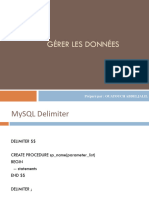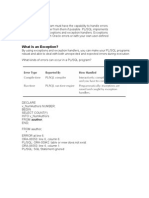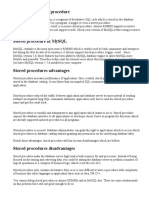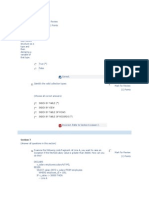1 Mysql Exception Handling
Uploaded by
460Maitreyee Shendye1 Mysql Exception Handling
Uploaded by
460Maitreyee ShendyeMySQL Error Handling in Stored Procedures
When an error occurs inside a stored procedure, it is important to handle it appropriately, such as
continuing or exiting the current code block’s execution, and issuing a meaningful error message.
MySQL provides an easy way to define handlers that handle from general conditions such as warnings
or exceptions to specific conditions e.g., specific error codes.
Declaring a handler
To declare a handler, you use the DECLARE HANDLER statement as follows:
DECLARE action HANDLER FOR condition_value statement;
If a condition whose value matches the condition_value , MySQL will execute the statement and
continue or exit the current code block based on the action .
The action accepts one of the following values:
CONTINUE : the execution of the enclosing code block ( BEGIN … END ) continues.
EXIT : the execution of the enclosing code block, where the handler is declared, terminates.
The condition_value specifies a particular condition or a class of conditions that activates the
handler. The condition_value accepts one of the following values:
A MySQL error code.
A standard SQLSTATE value. Or it can be an SQLWARNING , NOTFOUND or SQLEXCEPTION
condition, which is shorthand for the class of SQLSTATE values. The NOTFOUND condition is used
for a cursor or SELECT INTO variable_list statement.
A named condition associated with either a MySQL error code or SQLSTATE value.
The statement could be a simple statement or a compound statement enclosing by the BEGIN and END
keywords.
The following handler means that if an error occurs, set the value of the has_error variable to 1 and
continue the execution.
DECLARE CONTINUE HANDLER FOR SQLEXCEPTION SET has_error = 1;
DECLARE CONTINUE HANDLER FOR NOT FOUND SET no_row_found = 1;
The following handler means that if a duplicate key error occurs, MySQL error 1062 is issued. It issues
an error message and continues execution.
DECLARE CONTINUE HANDLER FOR 1062
SELECT 'Error, duplicate key occurred';
You might also like
- MySQL Error Handling in Stored ProceduresNo ratings yetMySQL Error Handling in Stored Procedures9 pages
- SQL Error Logging and Exception HandlingNo ratings yetSQL Error Logging and Exception Handling8 pages
- Experiment 6: Write The Queries To Implement The Subqueries Basic SubqueryNo ratings yetExperiment 6: Write The Queries To Implement The Subqueries Basic Subquery15 pages
- Error Handling: Any Well-Written Program Must Have The Capability To Handle ErrorsNo ratings yetError Handling: Any Well-Written Program Must Have The Capability To Handle Errors12 pages
- DBMS - Unit 3 - Notes (Embedded & Dynamic SQL)No ratings yetDBMS - Unit 3 - Notes (Embedded & Dynamic SQL)23 pages
- What Is PL/SQL?: PL/SQL Stands For Procedural Language Extension of SQLNo ratings yetWhat Is PL/SQL?: PL/SQL Stands For Procedural Language Extension of SQL25 pages
- Starting With Anonymous Block in PL SQLNo ratings yetStarting With Anonymous Block in PL SQL12 pages
- Using The Multiple-Row FETCH Statement: Step 1:declare A CursorNo ratings yetUsing The Multiple-Row FETCH Statement: Step 1:declare A Cursor5 pages
- Transactions in SQL Server Integration Services SSISNo ratings yetTransactions in SQL Server Integration Services SSIS5 pages
- Ex - No: 6 Date:16.02.2019 Write A PL/SQL Block To Satisfy Some Conditions by Accepting Input From The UserNo ratings yetEx - No: 6 Date:16.02.2019 Write A PL/SQL Block To Satisfy Some Conditions by Accepting Input From The User8 pages
- Oracle PL/SQL Best Practice 2.1 Overview: 1.1 ScopeNo ratings yetOracle PL/SQL Best Practice 2.1 Overview: 1.1 Scope7 pages
- Home Ai Machine Learning Dbms Java Blockchain Control System Selenium HTML Css Javascript Ds JqueryNo ratings yetHome Ai Machine Learning Dbms Java Blockchain Control System Selenium HTML Css Javascript Ds Jquery12 pages
- BE EXPERT IN JAVA Part- 2: Learn Java programming and become expertFrom EverandBE EXPERT IN JAVA Part- 2: Learn Java programming and become expertNo ratings yet
- Advanced SAS Interview Questions You'll Most Likely Be AskedFrom EverandAdvanced SAS Interview Questions You'll Most Likely Be AskedNo ratings yet
- JavaScript Fundamentals: JavaScript Syntax, What JavaScript is Use for in Website Development, JavaScript Variable, Strings, Popup Boxes, JavaScript Objects, Function, and Event HandlersFrom EverandJavaScript Fundamentals: JavaScript Syntax, What JavaScript is Use for in Website Development, JavaScript Variable, Strings, Popup Boxes, JavaScript Objects, Function, and Event HandlersNo ratings yet
- JavaScript Fundamentals: JavaScript Syntax, What JavaScript is Use for in Website Development, JavaScript Variable, Strings, Popup Boxes, JavaScript Objects, Function, and Event Handlers: JavaScript Syntax, What JavaScript is Use for in Website Development, JavaScript Variable, Strings, Popup Boxes, JavaScript Objects, Function, and Event HandlersFrom EverandJavaScript Fundamentals: JavaScript Syntax, What JavaScript is Use for in Website Development, JavaScript Variable, Strings, Popup Boxes, JavaScript Objects, Function, and Event Handlers: JavaScript Syntax, What JavaScript is Use for in Website Development, JavaScript Variable, Strings, Popup Boxes, JavaScript Objects, Function, and Event HandlersNo ratings yet



























































